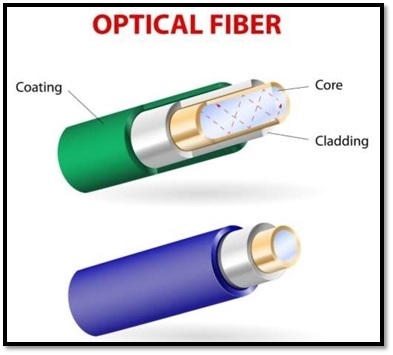
 Data Structure
Data Structure Networking
Networking RDBMS
RDBMS Operating System
Operating System Java
Java MS Excel
MS Excel iOS
iOS HTML
HTML CSS
CSS Android
Android Python
Python C Programming
C Programming C++
C++ C#
C# MongoDB
MongoDB MySQL
MySQL Javascript
Javascript PHP
PHP
- Selected Reading
- UPSC IAS Exams Notes
- Developer's Best Practices
- Questions and Answers
- Effective Resume Writing
- HR Interview Questions
- Computer Glossary
- Who is Who
Fiber Cables
Optical fiber cables are transparent, flexible fibers made up of glass or plastic through which light waves can pass. A bunch of fiber optic cables is shown in the following diagram −

Structure of a Fiber – Optic Cable
A cross section of a fiber optic cable reveals three parts −
Core − It is the innermost portion of an optical fiber through which light propagates. It is cylindrical in shape and it made up of a flexible glass of high refractive index. The diameter of the core of a single mode fiber is 8 – 10 μm while multimode fibers are 50 μm in diameter. It is also called the optical waveguide since it is the main channel through which light signals are transmitted.
Cladding − The core is surrounded by a glass cladding. The glass of cladding has a lower refractive index than the core. This enables total internal reflection of light waves in the core, and eventually propagation of light waves within the core.
Outer Coating or Jacket − The outer jacket is a thin plastic sheath or coating that is opaque to light. It prevents light rays from outside to enter the optical fiber. Fibers are typically bundles together, where each bundle is covered by a protective outer sheath that prevents the fibers from physical damage.
The following figure gives a three-dimensional section of a fiber – optic cable.

Connection of Optical Fibers
Fiber optic cables need to be connected so that there is no leakage of light signals. There are three types of connectors −
- Subscriber Channel (SC) Connector: used in cable TV
- Straight – Tip (ST) Connector: used for connecting to networking devices
- MT – RJ Connector: similar to RJ connector
Types of Optical Fibers
There are two types of fibers −
Step-index fiber : In these, the refractive index of the core is constant and undergoes an abrupt change at the interface with the cladding.
Graded-index fiber: The refractive index of the core varies in a radial manner from the center. The fiber is densest at the core and becomes rarer towards the edge of the core.
Both of these are further divided into two categories depending upon propagation modes of the fibers −
- Single-mode fiber
- Multi-mode fiber

